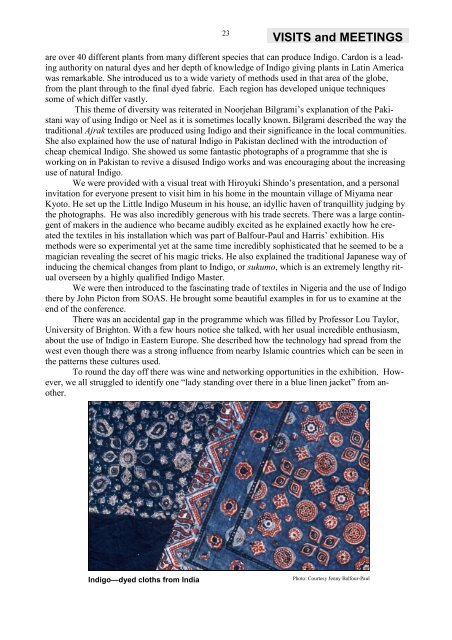Download - OATG. Oxford Asian Textile Group
Download - OATG. Oxford Asian Textile Group
Download - OATG. Oxford Asian Textile Group
Create successful ePaper yourself
Turn your PDF publications into a flip-book with our unique Google optimized e-Paper software.
23<br />
VISITS and MEETINGS<br />
are over 40 different plants from many different species that can produce Indigo. Cardon is a leading<br />
authority on natural dyes and her depth of knowledge of Indigo giving plants in Latin America<br />
was remarkable. She introduced us to a wide variety of methods used in that area of the globe,<br />
from the plant through to the final dyed fabric. Each region has developed unique techniques<br />
some of which differ vastly.<br />
This theme of diversity was reiterated in Noorjehan Bilgrami‘s explanation of the Pakistani<br />
way of using Indigo or Neel as it is sometimes locally known. Bilgrami described the way the<br />
traditional Ajrak textiles are produced using Indigo and their significance in the local communities.<br />
She also explained how the use of natural Indigo in Pakistan declined with the introduction of<br />
cheap chemical Indigo. She showed us some fantastic photographs of a programme that she is<br />
working on in Pakistan to revive a disused Indigo works and was encouraging about the increasing<br />
use of natural Indigo.<br />
We were provided with a visual treat with Hiroyuki Shindo‘s presentation, and a personal<br />
invitation for everyone present to visit him in his home in the mountain village of Miyama near<br />
Kyoto. He set up the Little Indigo Museum in his house, an idyllic haven of tranquillity judging by<br />
the photographs. He was also incredibly generous with his trade secrets. There was a large contingent<br />
of makers in the audience who became audibly excited as he explained exactly how he created<br />
the textiles in his installation which was part of Balfour-Paul and Harris‘ exhibition. His<br />
methods were so experimental yet at the same time incredibly sophisticated that he seemed to be a<br />
magician revealing the secret of his magic tricks. He also explained the traditional Japanese way of<br />
inducing the chemical changes from plant to Indigo, or sukumo, which is an extremely lengthy ritual<br />
overseen by a highly qualified Indigo Master.<br />
We were then introduced to the fascinating trade of textiles in Nigeria and the use of Indigo<br />
there by John Picton from SOAS. He brought some beautiful examples in for us to examine at the<br />
end of the conference.<br />
There was an accidental gap in the programme which was filled by Professor Lou Taylor,<br />
University of Brighton. With a few hours notice she talked, with her usual incredible enthusiasm,<br />
about the use of Indigo in Eastern Europe. She described how the technology had spread from the<br />
west even though there was a strong influence from nearby Islamic countries which can be seen in<br />
the patterns these cultures used.<br />
To round the day off there was wine and networking opportunities in the exhibition. However,<br />
we all struggled to identify one ―lady standing over there in a blue linen jacket‖ from another.<br />
Indigo—dyed cloths from India<br />
Photo: Courtesy Jenny Balfour-Paul

















